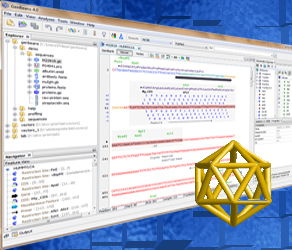ADVERTISEMENT
Drawing Proteins
A tool for colouring your amino acid sequences
By exploiting recent advances in programmable graphics cards, the ProteinShader program can produce illustrative renderings of proteins that approximate what an artist might create using pen and ink. The custom texture mapping and lighting calculations for rendering these images are implemented using vertex and fragment shaders written in the OpenGL Shading Language, which is supported on most new graphics cards for ordinary desktop and laptop computers.
QuteMol is an open source (GPL), interactive, high quality molecular visualization system. QuteMol exploits the current GPU capabilites through OpenGL shaders to offers an array of innovative visual effects. QuteMol visualization techniques are aimed at improving clarity and an easier understanding of the 3D shape and structure of large molecules or complex proteins.
Protein structure visualization server can be used to generate schematic representations of secondary structures and relative solvent accessibilities, allowing one to highlight selected residues, e.g. polymorphic or involved in protein-protein interactions.
Helical wheel drawing program by John K. Everett
This tool allows to generate custom protein domain figures.
Protter, a web-application for interactive integration and visualization of annotated and predicted protein sequence features together with experimental proteomic evidence
The Persistence of Vision Raytracer is a high-quality, totally free tool for creating stunning three-dimensional graphics, for expert only.
RbDe is a web application to create and edit residue-based diagrams of (mostly transmembrane) proteins.
TransMembrane protein Re-Presentation in 2 Dimensions' tool, automates the creation of uniform, two-dimensional, high analysis graphical images/models of alpha-helical or beta-barrel transmembrane proteins.
Free, user-friendly server that converts PDB files to animated gif files that can be used in Web pages and presentations.
TOPO2 is an open source program written in Python for the creation of transmembrane protein 2D topology images. It makes no attempt to predict the TMDs that it displays. The user needs to supply that information. Residues of interest can be highlighted, if desired.
A Graphical Tool for Protein Domain and Exon Position Visualization
MolPOV is a graphics file converter that reads Brookhaven Protein Data Bank format files and produces a ready-to-render input file for the Persistence of Vision ray tracer (POV-Ray).
COMBOSA (Coloring Of Molecules Based On Sequence Alignment) is used to color a three dimensional representation of a protein according to the results of a sequence alignment. The program accepts a group of aligned sequences in FASTA or GDE format (one of the sequences must have a solved three dimensional structure), and it generates a script that can be used by a molecular visualization program (RasMol). The script adjusts the color and appearance of the molecule so that conserved residues are highlighted.
The Web Bench
The Web Bench
is the essential companion to the biologist, bringing informational resources and a collection of tools & calculators to facilitate work at the bench and analysis of biological data.
Check out the full online bench here
Check out the full online bench here
Sequence Analysis with GenBeans
 Try GenBeans: Best free software for DNA sequence editing!
Try GenBeans: Best free software for DNA sequence editing!
FEEDBACK
Your comments & your suggestionsare appreciated. Please, notify us for resources and tools that you would like to see on this bench!





